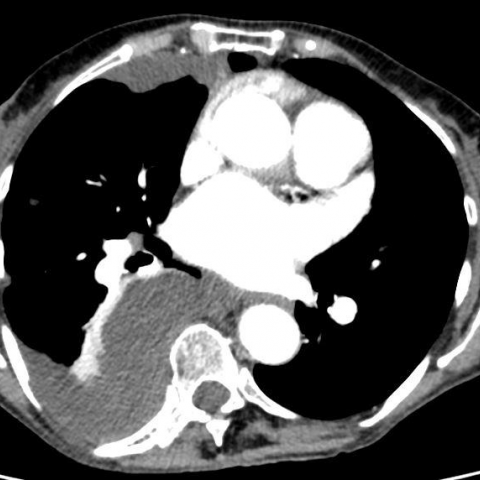Thoracic CT
Synchronous pleural involvement in a patient with pseudomyxoma peritonei
SectionAbdominal imaging
Case TypeClinical Cases
AuthorsDavid A, Amil M, Pavageau AH, Visee E, Frampas E
Patient81 years, female
Routine laboratory investigations were within normal limits.
We performed a thoracic contrast-enhanced computed tomography (CT) at arterial phase and an abdominal contrast-enhanced CT at portal phase.
Thoracic CT revealed thickened pleura with lobulated masses of water attenuation in the right hemithorax, causing a mediastinal shift (Fig. 1). Neither parenchymatous mass nor mediastinal lymphadenopathy were observed.
Abdominal CT showed a large-volume ascites with scalloping of the liver surface (Fig. 2), curvilinear calcification in the right paracolic gutter (Fig. 3), central displacement of the small bowel (Fig. 4), and a voluminous appendiceal tumour with calcification (Fig. 5). Neither liver metastasis nor lymphadenopathy were present.
Peritoneal and pleural aspiration showed abundant mucinous material. Cytological examination of the fluid showed mucus with cohesive aggregates of mucoproducing epithelial cells (Fig. 6). The immunohistochemical profile revealed epithelial membranous positivity to CK20 and CEA (Fig. 7), while negativity was registered to calretinin.
Although this tumour is only superficially invasive, death is mainly due to intestinal obstruction by tumour masses.
The mucin-producing cells in PP are poorly adherent, explaining the wide distribution of large tumour deposits. They mainly seed at sites of relative stasis, circulating with peritoneal fluid and dislodged from the surface of the bowel by peristalsis [3]. The pelvis, the subphrenic spaces, the right paracolic gutter and the surface of the liver and spleen are therefore the commonest involved sites [4].
Intrathoracic spread of PP is a rare condition, occurring in 5.4% of cases of pseudomyxoma peritonei, according to an American study published in 2000 [5]. The authors reported that pleural involvement was due to direct extension through the diaphragm in all 23 patients [5]. Iatrogenic perforation of the diaphragm, occurring during subdiaphragmatic peritonectomy, is the most frequent mechanism. For those patients, pleural extension is detected during follow-up after the initial abdominal cytoreductive surgery [5, 6]. Congenital pleuroperitoneal communications, direct invasion of the diaphragm, haematogenous dissemination can also lead to pleural extension [5].
In our case, the synchronous pleural involvement of pseudomyxoma peritonei was presumed to be the result of the invasion of the central tendon of the diaphragm by the voluminous mucinous tumour, leading to the extension into the pleural space. The patient had an extensive peritoneal involvement with a thick layer of tumour on the undersurface of the right hemidiaphragm.
Imaging plays a major role in the diagnosis of PP. Ultrasonography shows non-mobile echogenic ascites with scalloping of the hepatic and splenic margins [7].
On CT, PP appears of low attenuation, with the presence of the following features: visceral scalloping, septae or calcification in the mucinous material, central displacement of the small bowel, and appendiceal tumour [4, 7].
Magnetic resonance imaging may provide similar information with ascites, peritoneal implants and scalloping [8].
From a histological point of view, different entities should be distinguished: disseminated peritoneal adenomucinosis, peritoneal mucinous carcinomatosis, with a different microscopic appearance [9]. Current treatment of PP consists of complete cytoreduction, using peritonectomy procedures, in combination with heated intraoperative intraperitoneal chemotherapy [5]. Bicavitary hyperthermic chemoperfusion is used for disease involving the pleural cavity [5, 10].
[1] Ronnet BM, Zhan CM, Kurman RJ (1995) A clinicopathological analysis of 109 cases with emphasis on distinguishing pathologic feature, site of origin and relationship to pseudommyxoma peritonei. Am J Surg Pathol 19:1390-408 (PMID: 7503361)
[2] Young RH (2004) Pseudomyxoma peritonei and selected other aspects of the spread of appendiceal neoplasms. Semin Diagn Pathol 2:134-150 (PMID: 15807473)
[3] Sugarbaker PH (1997) Pseudomyxoma peritonei syndrome. Adv Surg 30:233-280 (PMID: 8960339)
[4] Sulkin TV (2002) CT in pseudomyxoma peritonei : a review of 17 case. Clin Radiol 57(7):608-13 (PMID: 12096860)
[5] Pestieau SR, Esquivel J, Sugarbaker PH (2000) Pleural extension of mucinous tumor in patients with pseudomyxoma peritonei syndrome. Ann Surg Oncol 7(3):199-203 (PMID: 10791850)
[6] Lee BY, Kim HS, Lee SH, Lee JM (2004) Pseudomyxoma peritonei : extraperitoneal spread to the pleural cavity and lung. J Thorac Imaging 7(3):199-203 (PMID: 15071333)
[7] Seshul MB, Coulam CM (1981) Pseudomyxoma peritonei : computed tomography and sonography. AJR 136:803-6 (PMID: 6261563)
[8] Menassa-Moussa L (2008) Peritoneal pseudomyxoma of appendiceal origin : MR imaging features. J Radiol 89:1105-8 (PMID: 18772791)
[9] Bryant J (2005) Systematic review of the Sugarbaker procedure for pseudomyxoma peritonei. Br J Surg 92,53 (PMID: 15685704)
[10] Senthil M (2009) Simultanous bicavitary hyperthermuc chemoperfusion in the management of pseudomyxoma peritonei with synchronous pleural extension. Arch Sur 144:970-2 (PMID: 19841367)
| URL: | https://www.eurorad.org/case/13314 |
| DOI: | 10.1594/EURORAD/CASE.13314 |
| ISSN: | 1563-4086 |
This work is licensed under a Creative Commons Attribution-NonCommercial-ShareAlike 4.0 International License.





















